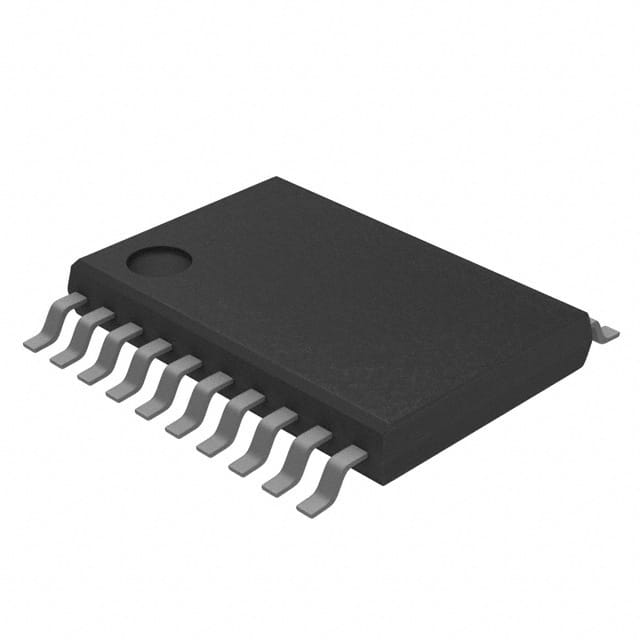PCF8574APW
Product Overview
Category
The PCF8574APW belongs to the category of semiconductor integrated circuits.
Use
It is commonly used as an I/O expander for microcontroller-based systems, allowing for increased input and output capabilities.
Characteristics
- Package: TSSOP (Thin Shrink Small Outline Package)
- Essence: 8-bit remote I/O expander for I2C-bus with interrupt
- Packaging/Quantity: Tape and Reel (2500 units per reel)
Specifications
The PCF8574APW features: - 8-bit remote I/O expander for the I2C-bus - Open-drain interrupt output - Low standby current consumption of 10 µA maximum - Operating power supply voltage range of 2.5 V to 6 V - 400 kHz fast I2C-bus - Three hardware address pins allowing up to eight devices on the bus
Detailed Pin Configuration
The pin configuration of the PCF8574APW includes: 1. P0-P7: I/O Ports 2. A0-A2: Hardware Address Pins 3. INT: Interrupt Output 4. SDA: Serial Data Line 5. SCL: Serial Clock Line 6. GND: Ground 7. VCC: Power Supply
Functional Features
The functional features of the PCF8574APW include: - Expandable I/O using the I2C-bus - Interrupt capability for efficient communication - Low power consumption for energy efficiency
Advantages and Disadvantages
Advantages
- Simplifies I/O expansion in microcontroller systems
- Allows for easy integration with existing I2C-bus systems
- Low standby current consumption enhances power efficiency
Disadvantages
- Limited to 8-bit I/O expansion
- Requires understanding of I2C-bus protocol for effective use
Working Principles
The PCF8574APW operates by communicating with a microcontroller through the I2C-bus, expanding the available I/O ports and providing interrupt capabilities when connected devices require attention.
Detailed Application Field Plans
The PCF8574APW finds applications in various fields, including: - Home automation systems - Industrial control systems - Automotive electronics - Consumer electronics - Robotics
Detailed and Complete Alternative Models
Some alternative models to the PCF8574APW include: - MCP23008 - MAX7311 - SX1509
In conclusion, the PCF8574APW serves as a versatile I/O expander for microcontroller-based systems, offering expanded I/O capabilities and interrupt functionality. Its low power consumption and compatibility with the I2C-bus make it a valuable component in various electronic applications.
Word Count: 394
Lista 10 Vanliga frågor och svar relaterade till tillämpningen av PCF8574APW i tekniska lösningar
What is PCF8574APW?
- PCF8574APW is an 8-bit I/O expander for the I2C bus, which provides general-purpose remote I/O expansion for most microcontroller families via the I2C interface.
What is the operating voltage range of PCF8574APW?
- The operating voltage range of PCF8574APW is 2.5V to 6V.
How many I/O pins does PCF8574APW have?
- PCF8574APW has 8 I/O pins.
What is the maximum sink current per I/O pin of PCF8574APW?
- The maximum sink current per I/O pin of PCF8574APW is 25mA.
Can PCF8574APW be used with Arduino?
- Yes, PCF8574APW can be easily interfaced with Arduino using the I2C communication protocol.
What are the typical applications of PCF8574APW?
- Typical applications of PCF8574APW include LED displays, push-button interfaces, relay drivers, and other applications requiring I/O expansion.
What is the address range for PCF8574APW?
- The address range for PCF8574APW is from 0x20 to 0x27, allowing up to 8 devices to be connected on the same bus.
How do I configure PCF8574APW for input or output?
- Configuration for input or output is done by writing to the corresponding I/O direction register of PCF8574APW.
Can PCF8574APW handle interrupts?
- No, PCF8574APW does not have interrupt capabilities.
Is there a library available for PCF8574APW in popular microcontroller platforms?
- Yes, there are libraries available for PCF8574APW in platforms like Arduino, Raspberry Pi, and other microcontroller environments, making it easy to integrate into projects.


